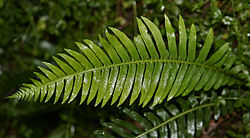ผลต่างระหว่างรุ่นของ "พืชบก"
| บรรทัด 63: | บรรทัด 63: | ||
* [[เฟิร์น|Pteridophyta]] (เฟิร์น, หวายทะนอย, และ [[หญ้าถอดปล้อง]]) |
* [[เฟิร์น|Pteridophyta]] (เฟิร์น, หวายทะนอย, และ [[หญ้าถอดปล้อง]]) |
||
พืชกลุ่มอื่นนั้นปรากฎครั้งแรกเมื่อเกือบถึงสุดสิ้นสุดในมหายุคพาลีโอโซอิก การสืบพันธุ์ใช้แคปซูลป้องกันการสูญเสียน้ำที่เรียกว่า[[เมล็ด]] ดังนั้นพืชกลุ่มนี้จึงเรียกว่า spermatophyte หรือพืชมีเมล็ด ในรูปแบบแกมีโทไฟต์หายไปโดยสมบูรณ์กลายเป็นรูปแบบ[[เรณู]]และ[[ไข่]]เซลล์เดียว ขณะที่สปอโรไฟต์เริ่มวงจรชีวิตของมันในเมล็ด เมล็ดของพืชบางชนิดสามารถอยู่รอดในสภาวะแห้งแล้งแบบสุดขั้วได้ ไม่เหมือนกับเมล็ดบางชนิดที่ต้องใช้น้ำจำนวนมากในการกระตุ้นให้งอก กลุ่มของพืชมีเมล็ดมีดังนี้: |
พืชกลุ่มอื่นนั้นปรากฎครั้งแรกเมื่อเกือบถึงสุดสิ้นสุดในมหายุคพาลีโอโซอิก การสืบพันธุ์ใช้แคปซูลป้องกันการสูญเสียน้ำที่เรียกว่า[[เมล็ด]] ดังนั้นพืชกลุ่มนี้จึงเรียกว่า spermatophyte หรือพืชมีเมล็ด ในรูปแบบแกมีโทไฟต์หายไปโดยสมบูรณ์กลายเป็นรูปแบบ[[เรณู]]และ[[ไข่]]เซลล์เดียว ขณะที่สปอโรไฟต์เริ่มวงจรชีวิตของมันถูกห่อหุ้มอยู่ในเมล็ด เมล็ดของพืชบางชนิดสามารถอยู่รอดในสภาวะแห้งแล้งแบบสุดขั้วได้ ไม่เหมือนกับเมล็ดบางชนิดที่ต้องใช้น้ำจำนวนมากในการกระตุ้นให้งอก กลุ่มของพืชมีเมล็ดมีดังนี้: |
||
* Cycadophyta (ปรง) |
* Cycadophyta (ปรง) |
||
| บรรทัด 71: | บรรทัด 71: | ||
* Magnoliophyta (พืชดอก) |
* Magnoliophyta (พืชดอก) |
||
พืชในสี่กลุ่มแรกเป็น[[พืชเมล็ดเปลือย]] ตั้งแต่สปอโรไฟต์ขั้นต้นไม่ถูกห่อหุ้มจนกระทั่งหลังการถ่ายเรณู ในทางตรงข้าม เรณูของพืชดอกจะเจริญเป็นหลอดสอดใส่เปลือกเมล็ด พืชดอกเป็นพืชกลุ่มหลักสุดท้ายที่วิวัฒนาการมากจากพืชเมล็ดเปลือยในระหว่าง[[ยุคจูแรสซิก]]และกระจายพันธุ์อย่างรวดเร็วระหว่าง[[ยุคครีเทเชียส]] พวกมันเป็นกลุ่มพืชที่มีมากที่สุดในสิ่งมีชีวิตบนโลก |
|||
<!--The first four groups are referred to as [[gymnosperm]]s, since the embryonic sporophyte is not enclosed until after pollination. In contrast, among the flowering plants or [[angiosperm]]s, the pollen has to grow a tube to penetrate the seed coat. Angiosperms were the last major group of plants to appear, developing from gymnosperms during the [[Jurassic]] period, and then spreading rapidly during the [[Cretaceous]]. They are the predominant group of plants in most [[Terrestrial plant|terrestrial]] [[biome]]s today. |
|||
== ความเป็นญาติกับสาหร่ายสีเขียว == |
|||
== Relationship to green algae == |
|||
Note that the higher-level [[Statistical classification|classification]] of plants varies considerably. Some authors have restricted the [[Kingdom (biology)|kingdom]] [[Plantae]] to include only embryophytes, others have given them various names and ranks. The groups listed here are often considered divisions or [[phylum|phyla]], but have also been treated as classes, and they are occasionally compressed into as few as two divisions. Some classifications, indeed, consider the term Embryophyta at the superphylum (superdivision) level, and include Land Plants and some Charophyceae in a subkingdom named [[Streptophyta]]. |
<!--Note that the higher-level [[Statistical classification|classification]] of plants varies considerably. Some authors have restricted the [[Kingdom (biology)|kingdom]] [[Plantae]] to include only embryophytes, others have given them various names and ranks. The groups listed here are often considered divisions or [[phylum|phyla]], but have also been treated as classes, and they are occasionally compressed into as few as two divisions. Some classifications, indeed, consider the term Embryophyta at the superphylum (superdivision) level, and include Land Plants and some Charophyceae in a subkingdom named [[Streptophyta]]. |
||
On a microscopic level, embryophyte cells remain very similar to those of green algae. They are [[eukaryote|eukaryotic]], with a [[cell wall]] composed of [[cellulose]] and [[plastid]]s surrounded by two membranes. These usually take the form of [[chloroplast]]s, which conduct photosynthesis and store food in the form of [[starch]], and characteristically are pigmented with chlorophylls ''a'' and ''b'', generally giving them a bright green color. Embryophytes also generally have an enlarged central [[vacuole]] or tonoplast, which maintains cell [[turgor]] and keeps the plant rigid. They lack [[flagellum|flagella]] and [[centriole]]s except in certain [[gamete]]s.--> |
On a microscopic level, embryophyte cells remain very similar to those of green algae. They are [[eukaryote|eukaryotic]], with a [[cell wall]] composed of [[cellulose]] and [[plastid]]s surrounded by two membranes. These usually take the form of [[chloroplast]]s, which conduct photosynthesis and store food in the form of [[starch]], and characteristically are pigmented with chlorophylls ''a'' and ''b'', generally giving them a bright green color. Embryophytes also generally have an enlarged central [[vacuole]] or tonoplast, which maintains cell [[turgor]] and keeps the plant rigid. They lack [[flagellum|flagella]] and [[centriole]]s except in certain [[gamete]]s.--> |
||
รุ่นแก้ไขเมื่อ 22:47, 16 กรกฎาคม 2552
| พืชบก ช่วงเวลาที่มีชีวิตอยู่: Late Silurian–Recent[1][2] (สปอร์จากยุคออร์โดวิเชียน) | |
|---|---|

| |
| ใบเฟิร์น | |
| การจำแนกชั้นทางวิทยาศาสตร์ | |
| โดเมน: | Eukaryota |
| อาณาจักรใหญ่: | Archaeplastida |
| อาณาจักร: | Plantae |
| อาณาจักรย่อย: | Embryophyta |
| ส่วน | |
| |
พืชบก (Embryophyte) คือกลุ่มพืชที่เราคุ้นเคยกันดี ประกอบไปด้วยต้นไม้, ไม้ดอก, เฟิร์น, มอสส์ และพืชบกสีเขียวอื่นๆ ทั้งหมดเป็นยูแคริโอตหลายเซลล์ที่สลับซับซ้อนที่มีอวัยวะสำหรับสืบพันธุ์เป็นแบบพิเศษ พืชบกได้รับพลังงานจากการสังเคราะห์ด้วยแสงและสังเคราะห์อาหารจากคาร์บอนไดออกไซด์ พืชบกอาจต่างจากสาหร่ายหลายเซลล์ที่ใช้คลอโรฟิลล์โดยสาหร่ายมีอวัยวะสืบพันธุ์นั้นเป็นหมัน พืชบกส่วนมากปรับตัวอาศัยอยู่บนบกแต่ก็มีบางส่วนอาศัยอยู่ในน้ำ
ความหลากหลายและการจำแนก
พืชบกวิวัฒนาการมาจากส่าหร่ายสีเขียวที่ซับซ้อน (Chlorophyta) ระหว่างมหายุคพาลีโอโซอิก สโตนเวิร์ตเป็นสิ่งที่แสดงถึงขั้นวิวัฒนาการนั้นได้ดีที่สุด พืชที่คล้ายสาหร่ายนี้อยู่ภายใต้การสลับของวงจรชีวิตระหว่างมีโครโมโซมหนึ่งชุดและมีโครโมโซมสองชุด (หรือที่เรียกว่าแกมีโทไฟต์และสปอโรไฟต์)
พืชไม่มีท่อลำเลียง
พืชไม่มีท่อลำเลียงเป็นพืชกลุ่มแรกในพืชบก อย่างไรก็ตามสปอโรไฟต์ในพืชกลุ่มนี้เป็นสิ่งที่แตกต่างออกไปอย่างมากในโครงสร้างและฟังก์ชัน วงจรชีวิตสั้นและต้องมีทั้งพ่อและแม่ พืชเหล่านี้เรียกว่า 'ไบรโอไฟต์' มีอยู่สามกลุ่ม:
- Bryophyta (มอสส์)
- Anthocerotophyta (ฮอร์นเวิร์ต)
- Marchantiophyta (ลิเวอร์เวิร์ต)
พืชเหล่านี้มีขนาดเล็กและอาศัยอยู่ในสิ่งแวดล้อมที่เปียกชื้น อาศัยน้ำในการแพร่กระจายสปอร์
พืชมีท่อลำเลียง
พืชอื่นที่สามารถปรับตัวให้เข้ากับสภาพแวดล้อมบนบกได้ดีกว่าปรากฎอยู่ในช่วงยุคไซลูเรียน ระหว่างยุคดิโวเนียนพืชมีหลากหลายขึ้นและกระจายในสภาพแวดล้อมที่ต่างกันกลายเป็นพืชมีท่อลำเลียงหรือเทรคีโอไฟต์ (tracheophytes) ซึ่งมีเนื้อเยื่อท่อลำเลียงหรือเทรคีดซึ่งใช้ส่งผ่านน้ำตลอดทั่วลำต้นและผิวนอกเพื่อป้องกันเนื้อเยื่อถูกทำลายจากการสูญเสียน้ำ ในพืชมีท่อลำเลียงส่วนมาก สปอโรไฟต์จะเป็นช่วงวงจรที่เหนือกว่าและมีการพัฒนาใบแท้จริง, ลำต้น และ ราก ขณะที่แกมีโทไฟต์เหลือเป็นช่วงสั้นๆ
พืชมีท่อลำเลียงหลายชนิดยังคงใช้สปอร์ในการกระจายพันธุ์ มีอยู่สองกลุ่ม:
- Lycopodiophyta (คลับมอสส์)
- Pteridophyta (เฟิร์น, หวายทะนอย, และ หญ้าถอดปล้อง)
พืชกลุ่มอื่นนั้นปรากฎครั้งแรกเมื่อเกือบถึงสุดสิ้นสุดในมหายุคพาลีโอโซอิก การสืบพันธุ์ใช้แคปซูลป้องกันการสูญเสียน้ำที่เรียกว่าเมล็ด ดังนั้นพืชกลุ่มนี้จึงเรียกว่า spermatophyte หรือพืชมีเมล็ด ในรูปแบบแกมีโทไฟต์หายไปโดยสมบูรณ์กลายเป็นรูปแบบเรณูและไข่เซลล์เดียว ขณะที่สปอโรไฟต์เริ่มวงจรชีวิตของมันถูกห่อหุ้มอยู่ในเมล็ด เมล็ดของพืชบางชนิดสามารถอยู่รอดในสภาวะแห้งแล้งแบบสุดขั้วได้ ไม่เหมือนกับเมล็ดบางชนิดที่ต้องใช้น้ำจำนวนมากในการกระตุ้นให้งอก กลุ่มของพืชมีเมล็ดมีดังนี้:
- Cycadophyta (ปรง)
- Ginkgophyta (แป๊ะก๊วย )
- Pinophyta (สน)
- Gnetophyta (มะเมื่อย)
- Magnoliophyta (พืชดอก)
พืชในสี่กลุ่มแรกเป็นพืชเมล็ดเปลือย ตั้งแต่สปอโรไฟต์ขั้นต้นไม่ถูกห่อหุ้มจนกระทั่งหลังการถ่ายเรณู ในทางตรงข้าม เรณูของพืชดอกจะเจริญเป็นหลอดสอดใส่เปลือกเมล็ด พืชดอกเป็นพืชกลุ่มหลักสุดท้ายที่วิวัฒนาการมากจากพืชเมล็ดเปลือยในระหว่างยุคจูแรสซิกและกระจายพันธุ์อย่างรวดเร็วระหว่างยุคครีเทเชียส พวกมันเป็นกลุ่มพืชที่มีมากที่สุดในสิ่งมีชีวิตบนโลก
ความเป็นญาติกับสาหร่ายสีเขียว
อ้างอิง
- ↑ Gray, J. (1985). (19850402) 309%3A1138%3C167%3ATMROEL%3E2.0.CO%3B2-E "The Microfossil Record of Early Land Plants: Advances in Understanding of Early Terrestrialization, 1970-1984". Philosophical Transactions of the Royal Society of London. Series B, Biological Sciences. 309 (1138): 167–195. doi:10.1098/rstb.1985.0077.
{{cite journal}}: ตรวจสอบค่า|url=(help) - ↑ Wellman et al. 2003, Science
- Kenrick, Paul & Crane, Peter R. (1997). The Origin and Early Diversification of Land Plants: A Cladistic Study. Washington, D. C.: Smithsonian Institution Press. ISBN 1-56098-730-8.
- Raven, Peter H., Evert, Ray F., & Eichhorn, Susan E. (2005). Biology of Plants (7th ed.). New York: W. H. Freeman and Company. ISBN 0-7167-1007-2.
- Smith, Alan R., Kathleen M. Pryer, E. Schuettpelz, P. Korall, H. Schneider, & Paul G. Wolf. (2006). "A classification for extant ferns". Taxon 55 (3) : 705-731.
- Stewart, Wilson N. & Rothwell, Gar W. (1993). Paleobotany and the Evolution of Plants (2nd ed.). Cambridge: Cambridge University Press. ISBN 0-521-38294-7.
- Taylor, Thomas N. & Taylor, Edith L. (1993). The Biology and Evolution of Fossil Plants. Englewood Cliffs, NJ: Prentice Hall. ISBN 0-13-651589-4.
